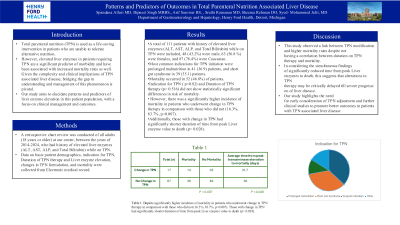Tuesday Poster Session
Category: Liver
P4571 - Patterns and Predictors of Outcomes in Total Parenteral Nutrition Associated Liver Disease
Tuesday, October 29, 2024
10:30 AM - 4:00 PM ET
Location: Exhibit Hall E

Has Audio

Spandana Alluri, MS, MD
Henry Ford Health
West Bloomfield, MI
Presenting Author(s)
Spandana Alluri, MS, MD1, Bipneet Singh, MBBS2, Arif Sarowar, 3, Sruthi Ramanan, MD4, Sheema Rehman, DO5, Syed-Mohammed Jafri, MD6
1Henry Ford Health, West Bloomfield, MI; 2Henry Ford Jackson Hospital, Detroit, MI; 3Wayne State School of Medicine, Detroit, MI; 4Henry Ford Jackson Hospital, Jackson, MI; 5Henry Ford Hospital, Detroit, MI; 6Henry Ford Health, Detroit, MI
Introduction: Total parenteral nutrition (TPN) is used as a life-saving intervention in patients who are unable to tolerate alternative nutrition. However, elevated liver enzymes in patients requiring TPN are a significant predictor of morbidity and have been associated with increased mortality rates as well. Given the complexity and clinical implications of TPN associated liver disease, bridging the gap in understanding and management of this phenomenon is pivotal. Our study aims to elucidate patterns and predictors of liver enzyme elevation in this patient population, with a focus on clinical management and outcomes.
Methods: A retrospective chart review was conducted of all adults (18 years or older) at our center (2014-2024) with history of elevated liver enzymes (ALT, AST, ALP, and Total Bilirubin) while on TPN. Data on basic patient demographics, indication for TPN, Duration of TPN therapy and Liver enzyme elevation, changes in TPN formulation, and mortality were collected.
Results: A total of 111 patients with history of elevated liver enzymes (ALT, AST, ALP, and Total Bilirubin) while on TPN were included, 48 (43.2%) were male, 63 (56.8 %) were females, and 87 (78.4%) were Caucasian. Most common indications for TPN initiation were prolonged malnutrition in 41 (36.9) patients, and short gut syndrome in 39 (35.1) patients. Mortality occurred in 52 (46.8%) of patients. Indication for TPN ( p=0.82) and Duration of TPN therapy (p= 0.516) did not show statistically significant differences in risk of mortality. However, there was a significantly higher incidence of mortality in patients who underwent change in TPN therapy in comparison with those who did not (16.3%, 83.7%, p=0.007). Additionally, those with change in TPN had significantly shorter duration of time from peak Liver enzyme value to death (p= 0.028).
Discussion: This study observed a link between TPN modification and higher mortality rates despite not having a correlation between duration on TPN therapy and mortality. In considering the simultaneous findings of significantly reduced time from peak Liver enzymes to death, this suggests that alterations in TPN therapy may be critically delayed till severe progression of liver disease. Our study highlights the need for early consideration of TPN adjustment and further clinical studies to promote better outcomes in patients with TPN associated liver disease.
Disclosures:
Spandana Alluri, MS, MD1, Bipneet Singh, MBBS2, Arif Sarowar, 3, Sruthi Ramanan, MD4, Sheema Rehman, DO5, Syed-Mohammed Jafri, MD6. P4571 - Patterns and Predictors of Outcomes in Total Parenteral Nutrition Associated Liver Disease, ACG 2024 Annual Scientific Meeting Abstracts. Philadelphia, PA: American College of Gastroenterology.
1Henry Ford Health, West Bloomfield, MI; 2Henry Ford Jackson Hospital, Detroit, MI; 3Wayne State School of Medicine, Detroit, MI; 4Henry Ford Jackson Hospital, Jackson, MI; 5Henry Ford Hospital, Detroit, MI; 6Henry Ford Health, Detroit, MI
Introduction: Total parenteral nutrition (TPN) is used as a life-saving intervention in patients who are unable to tolerate alternative nutrition. However, elevated liver enzymes in patients requiring TPN are a significant predictor of morbidity and have been associated with increased mortality rates as well. Given the complexity and clinical implications of TPN associated liver disease, bridging the gap in understanding and management of this phenomenon is pivotal. Our study aims to elucidate patterns and predictors of liver enzyme elevation in this patient population, with a focus on clinical management and outcomes.
Methods: A retrospective chart review was conducted of all adults (18 years or older) at our center (2014-2024) with history of elevated liver enzymes (ALT, AST, ALP, and Total Bilirubin) while on TPN. Data on basic patient demographics, indication for TPN, Duration of TPN therapy and Liver enzyme elevation, changes in TPN formulation, and mortality were collected.
Results: A total of 111 patients with history of elevated liver enzymes (ALT, AST, ALP, and Total Bilirubin) while on TPN were included, 48 (43.2%) were male, 63 (56.8 %) were females, and 87 (78.4%) were Caucasian. Most common indications for TPN initiation were prolonged malnutrition in 41 (36.9) patients, and short gut syndrome in 39 (35.1) patients. Mortality occurred in 52 (46.8%) of patients. Indication for TPN ( p=0.82) and Duration of TPN therapy (p= 0.516) did not show statistically significant differences in risk of mortality. However, there was a significantly higher incidence of mortality in patients who underwent change in TPN therapy in comparison with those who did not (16.3%, 83.7%, p=0.007). Additionally, those with change in TPN had significantly shorter duration of time from peak Liver enzyme value to death (p= 0.028).
Discussion: This study observed a link between TPN modification and higher mortality rates despite not having a correlation between duration on TPN therapy and mortality. In considering the simultaneous findings of significantly reduced time from peak Liver enzymes to death, this suggests that alterations in TPN therapy may be critically delayed till severe progression of liver disease. Our study highlights the need for early consideration of TPN adjustment and further clinical studies to promote better outcomes in patients with TPN associated liver disease.
Disclosures:
Spandana Alluri indicated no relevant financial relationships.
Bipneet Singh indicated no relevant financial relationships.
Arif Sarowar indicated no relevant financial relationships.
Sruthi Ramanan indicated no relevant financial relationships.
Sheema Rehman indicated no relevant financial relationships.
Syed-Mohammed Jafri: Gilead, Takeda, Abbvie, Intercept, VectivBio – Advisor or Review Panel Member, Speakers Bureau.
Spandana Alluri, MS, MD1, Bipneet Singh, MBBS2, Arif Sarowar, 3, Sruthi Ramanan, MD4, Sheema Rehman, DO5, Syed-Mohammed Jafri, MD6. P4571 - Patterns and Predictors of Outcomes in Total Parenteral Nutrition Associated Liver Disease, ACG 2024 Annual Scientific Meeting Abstracts. Philadelphia, PA: American College of Gastroenterology.
